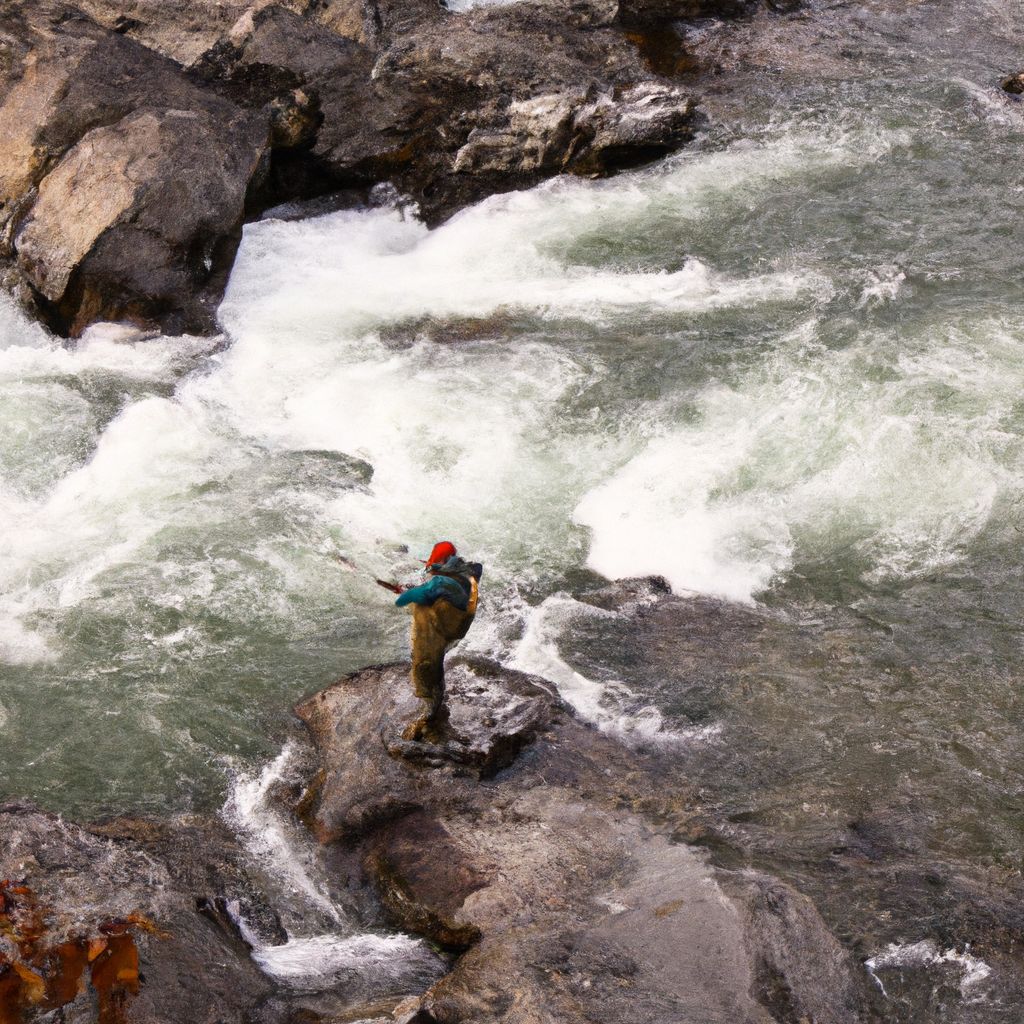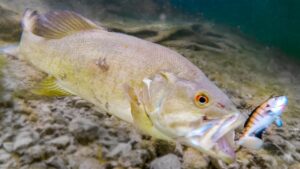Fishing in fast-flowing rivers is a challenging yet exciting experience. It requires unique skills and techniques. To succeed, one must understand how the river works and adapt their methods.
First, assess the current speed and identify areas where fish are likely to gather. These could include eddies, deep pools or submerged structures like rocks or fallen trees. Observe the water’s movement and the fish’s behavior. Strategically position yourself for success.
Use appropriate equipment to present your bait or lure. Heavier lines and sinkers combat the currents. Select lures that mimic the natural prey to entice bites.
Adjust your technique. Casting upstream allows your offering to drift naturally downstream. This mimics their feeding behavior and increases your chances of a strike.
Be patient and persistent. The powerful currents can be frustrating. Persevere and reap the rewards. You’ll learn to read the river’s nuances and discover productive spots hidden from casual observers.
Fish in fast-flowing rivers are like rebellious teens – they go against the current and refuse to be predictable.
Understanding the Behavior of Fish in Fast-Flowing Rivers
Fish behavior in fast-flowing rivers can be fascinating. To make successful fishing, we need to comprehend how fish act in such conditions. Fish have adapted to the strong currents and find food. Let’s take a look at some behavior of these fish:
Positioning: Fish stay in areas with slower currents, like behind rocks or under vegetation. This way they save energy and remain near their prey.
Feeding patterns: Fish use the water flow to search for food. They also gather near eddies and pockets where food accumulates.
Migratory habits: During certain times of the year, some species migrate upstream, overcoming the strong river currents to reach their spawning grounds.
Water temperature, oxygen levels, and predators can also modify fish behavior.
When fishing in fast-flowing rivers, anglers can use bait and lures to mimic the natural prey items. This will increase their chances of catching hungry fish.
Gaining knowledge about fish behavior in fast-flowing rivers will help anglers improve their fishing techniques and have more enjoyable and rewarding fishing trips.
Essential Gear and Techniques for Fishing in Fast-Flowing Rivers
Fishing in fast-flowing rivers calls for certain gear and techniques to boost your luck. Follow these helpful hints to stay afloat in these challenging waters:
- Buy a reliable fishing rod and reel set that can handle the strong currents. Opt for a medium-heavy or heavy action rod for better control.
- Utilize braided fishing line with a high pound test strength to survive the force of the river. This will stop your line from snapping and enable you to land bigger fish without worry.
- Toss weighted flies or lures to reach deeper water where fish usually gather in faster currents. Tungsten beads and sinkers can provide enough weight to sink your bait swiftly.
- Improve your casting upstream to put your bait naturally and let it get to your desired fishing spot. This strategy is important as it avoids too much drag on your line, improving your chances of catching bites.
- Grasp effective mending techniques by using upstream, downstream, or stack mends. Mending helps eliminate unwanted drag caused by conflicting current speeds, so your bait or fly can drift realistically.
For an even better fishing experience in fast-flowing rivers, check out these helpful tips:
- Learn about fish behavior and favored habitats in such river environments. Knowing their habits can help you spot potential hotspots.
- Try varying your retrieval speed and retrieve at angles against the current every now and then. This imitates injured prey, luring in predatory fish looking for an effortless meal.
- Test different colors and sizes of lures or flies until you identify what works best under particular river conditions. Adaptability is essential when dealing with ever-changing environments.
With these techniques in mind, you can up your chances of a successful fishing trip in fast-flowing rivers. Remember, adapting to the river’s conditions and understanding fish behavior are key for an enjoyable and productive experience. Cast your line like you’re auditioning for Riverdance, but be sure to reel in your expectations faster than a fish outrunning a cat!
Best Practices for Casting and Retrieving in Fast-Flowing Rivers
Fishing in fast rivers demands special techniques. Here are six tips to help you cast and retrieve with success:
- Perfect your cast. Accuracy and distance are key. Practice to make sure your bait or lure hits its target.
- Cast upstream or downstream. It all depends on the river flow. Upstream makes your bait drift towards you. Downstream helps retrieve your line.
- Adjust weights and sinkers. Heavier weights and closer placed sinkers help keep your bait at the right depth.
- Use sturdy lines. Braided or heavy-test monofilament lines can withstand the current.
- Vary your retrieve. Play around with speed and patterns. It’ll make your bait more attractive.
- Stay alert. Pay close attention and be ready for quick reactions.
Also, knowing the river topography is essential. Look for areas where slower and swifter flows meet. Fish love these spots.
I remember my first time fishing in a fast river. After some practice, I cast my line upstream and felt a tug. I skillfully reeled in a rainbow trout. It was awesome!
Follow these guidelines and you’ll be ready to tackle fast rivers. Good luck and happy fishing!
Locating and Reading Fish Hotspots in Fast-Flowing Rivers
Learn to locate and read fish hotspots in fast-flowing rivers with skill and precision. First, study the river environment. Observe the flow, identify slower areas, and look for structures providing shelter. Pay attention to temperature differences too.
Analyze fish behavior. Consider their feeding habits. Look for signs like jumping fish or birds hovering. Some species may prefer calmer eddies and pockets.
Finally, use effective baits and techniques. Choose bait that mimics natural food sources. Experiment with different baits and techniques. Adjust the speed and depth of your lure or bait.
Practice makes perfect. The more you gain experience, the better you’ll be at predicting where the fish will be. A study by The Fisheries Society of Taiwan suggests fishing in fast-flowing rivers requires adaptability and understanding of water dynamics. It’s like dating – find the perfect balance between patience and not getting swept away.
Safety Tips for Fishing in Fast-Flowing Rivers
Fishing in fast-flowing rivers can be thrilling, but it also carries risks. Necessary precautions must be taken to ensure safety. Wear appropriate safety gear like a life jacket and waders. Choose a spot carefully, considering depth and strength of the current. Be aware of surroundings and assess river conditions. Avoid unstable rocks or slippery surfaces. Look out for underwater obstacles like fallen trees or rocks.
Remember the weather conditions. Heavy rain can cause water levels and currents to change. Fish with a buddy or inform someone about plans.
A story to remind us of the importance of fishing safely in fast-flowing rivers: John went for a solo fishing trip. He was an experienced angler, but due to recent rain, the river had increased in intensity. John failed to notice and got carried away by the current. Thankfully, his quick thinking and swimming skills saved him.
Always stay alert, follow safety guidelines and respect nature’s power when fishing in fast-flowing rivers. Catching fish is like finding love on Tinder – you never know what you’re going to hook, but you’ll have stories to tell.
Techniques for Catching Different Species of Fish in Fast-Flowing Rivers
Fishin’ in fast-flowing rivers needs special techniques. Here’s some tips for catchin’ different types of fish:
- Use lightweight, sensitive gear so you can react fast when a fish bites.
- Match the bait or lure’s size and color to natural prey for the species you’re targetin’.
- Cast upstream and let your bait or lure flow with the current, imitatin’ natural movement.
- Try different retrieval techniques – slow and steady or quick jerks – to trigger strikes.
- Be patient and observant. Look for spots with slower currents, like eddies and behind rocks, where fish hide.
And knowin’ the details of each species can help you catch more. Like, trout hide in undercut banks or near submerged logs. Target them and your chances will go up. Smallmouth bass like rocks and swift currents. Fish near boulders and along gravel bars to snag ’em.
Here’s a true story to prove these techniques work. One summer my friend tried his luck fly fishing in a challengin’ river. He had the right rod and flies and ventured in.
He cast upstream and let his line drift downstream with the current. Suddenly, he felt a tug. With lightning speed, he set the hook and fought a rainbow trout. After a few heart-poundin’ minutes, he caught it! All thanks to the proper techniques for fast-flowing rivers.
Masterin’ the art of fishin’ in fast-flowing rivers takes time and practice. But with these techniques and some persistence, you’ll get the catch of a lifetime! Happy fishin’! Oh, and save the environment too – leave only footprints and take photos with your trophy!
Maintaining Environmental Conservation While Fishing in Fast-Flowing Rivers
Fishing in fast-flowing rivers needs mindful thought about nature. By following some easy tips, anglers can guarantee their fishing has little effect on the environment.
Start with the right gear and techniques. Use lightweight lures or flies instead of heavy sinkers. This helps avoid damage to the riverbed. Also, use artificial bait rather than live bait to protect native fish.
Be aware of your surroundings and practice responsible catch-and-release methods. Handle the fish with wet hands or use a rubber net. Revive exhausted fish before releasing them to guarantee their survival.
Be respectful of other anglers and practice proper etiquette. Cast lines away from other fishermen. Bring any trash or fishing line debris home instead of leaving it behind. This will help keep fast-flowing rivers beautiful for future generations.
By using these responsible approaches, we can enjoy fishing and help maintain balance in fast-flowing river ecosystems. Tom, an avid angler, found out the hard way. He was casting his line in a rapid river surrounded by beauty, only to see discarded plastic bottles bobbing along. So, he took a break and cleaned up the area for an hour. His reward? A huge rainbow trout! A reminder that respecting nature means enjoying its gifts more abundantly.
Conclusion: Mastering the Art of Fishing in Fast-Flowing Rivers
Are you ready to master the art of fishing in fast-flowing rivers? Here are some tips to help you succeed:
- Choose the right gear and bait.
- Understand the river’s current.
- Use a weighted line.
- Be patient and persistent.
- Prioritize safety by wearing appropriate gear.
Keep all these tips in mind for a successful fishing trip!
Oh, and remember to research local regulations and get any necessary permits before you go.





